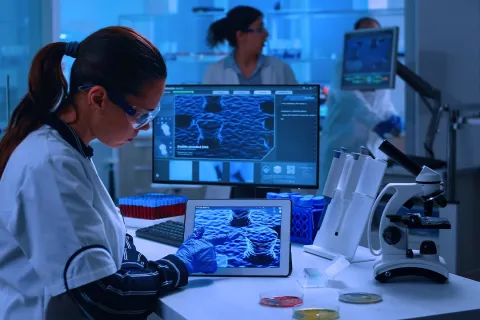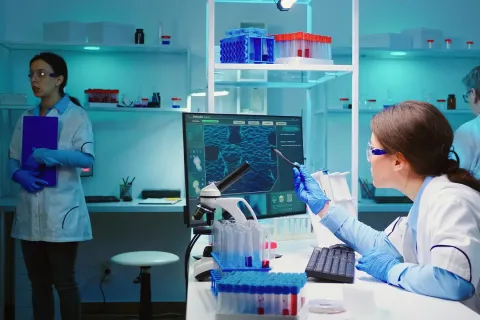
Automation has emerged as a game-changer, promising enhanced efficiency and accuracy. However, as we embrace these technological advancements, we must also confront a critical challenge: safeguarding sensitive data in automated medical writing processes.
The blog details the balance between leveraging cutting-edge automation tools and maintaining the highest standards of data security in the medical writing industry.
The integration of automated writing processes in medical communications brings unprecedented opportunities for efficiency and consistency. However, it also introduces new vulnerabilities in data security. Medical writers often handle highly sensitive information, including patient data, proprietary research findings, and confidential clinical trial results. As this information flows through automated systems, the risk of data breaches, unauthorized access, and potential misuse increases significantly. The challenge lies in harnessing the power of automation while ensuring robust protection of sensitive medical information throughout the writing process.
Safeguarding Data Security in Automated Writing Processes:
- Encryption and Access Control:
Implementing end-to-end encryption for all data processed through automated writing systems is crucial. This should be coupled with stringent access control measures, ensuring that only authorized personnel can view or modify sensitive information. Multi-factor authentication and role-based access controls are essential components of a secure automated writing environment. - Secure Cloud Integration:
Many automated writing tools leverage cloud technology for enhanced collaboration and accessibility. Ensuring that these cloud services comply with healthcare data protection standards (e.g., HIPAA in the US, and GDPR in Europe) is paramount. Regular security audits of cloud infrastructure should be conducted to identify and address potential vulnerabilities. - Data Anonymization Techniques:
Incorporating robust data anonymization processes within automated writing workflows can significantly reduce the risk of personal data exposure. Advanced algorithms can automatically detect and anonymize sensitive information, such as patient identifiers while preserving the integrity of the medical content. - Audit Trails and Version Control:
Implementing comprehensive audit trails and version control systems within automated writing processes allows for detailed tracking of all data access and modifications. This not only enhances security but also ensures Regulatory compliance for document traceability. - AI-Powered Threat Detection:
Leveraging artificial intelligence for real-time threat detection can provide an additional layer of security. AI algorithms can monitor data flows, identify unusual patterns, and alert administrators to potential security breaches or unauthorized access attempts. - Regular Security Training:
Even with advanced technological safeguards, human factors remain a critical component of data security. Regular training sessions for medical writers and all personnel involved in automated writing processes are essential to maintain awareness of security protocols and best practices.
Table: Data Security Measures in Traditional vs. Automated Medical Writing
| Security Aspect | Traditional Writing | Automated Writing |
|---|---|---|
| Data Storage | Local servers or physical documents | Encrypted cloud storage |
| Access Control | Manual permissions | Role-based access with MFA |
| Data Anonymization | Manual redaction | Automated AI-driven anonymization |
| Version Control | Manual tracking | Automated audit trails |
| Threat Detection | Periodic manual audits | Real-time AI-powered monitoring |
| Collaboration Security | Physical document control | Secure digital collaboration platforms |
Significance of Medical Writing Partner:
In navigating the complex landscape of data security in automated medical writing, Regulatory partners play a crucial role:
- Compliance Guidance: Providing expertise on relevant data protection regulations (e.g., HIPAA, GDPR) and ensuring automated processes align with these requirements.
- Risk Assessment: Conducting thorough risk assessments of automated medical writing systems to identify potential vulnerabilities.
- Security Protocol Development: Assisting in the development and implementation of robust security protocols tailored to automated medical writing processes.
- Validation Support: Offering validation services for automated medical writing tools to ensure they meet Regulatory standards for data security.
- Audit Preparation: Helping clients prepare for Regulatory audits by ensuring all automated writing processes are compliant and well-documented.
As the medical writing industry embraces automation, safeguarding data security becomes increasingly critical. By implementing technologies organizations can harness the benefits of automated medical writing processes while maintaining the highest data protection standards.
The role of Regulatory partners who deal with automation in medical writing cannot be overstated – their expertise ensures that technological innovations align with stringent Regulatory requirements and industry best practices. As we progress, the successful integration of automated medical writing tools will depend on our ability to balance innovation with unwavering commitment to data security. To learn more about our automation in medical writing click here.









